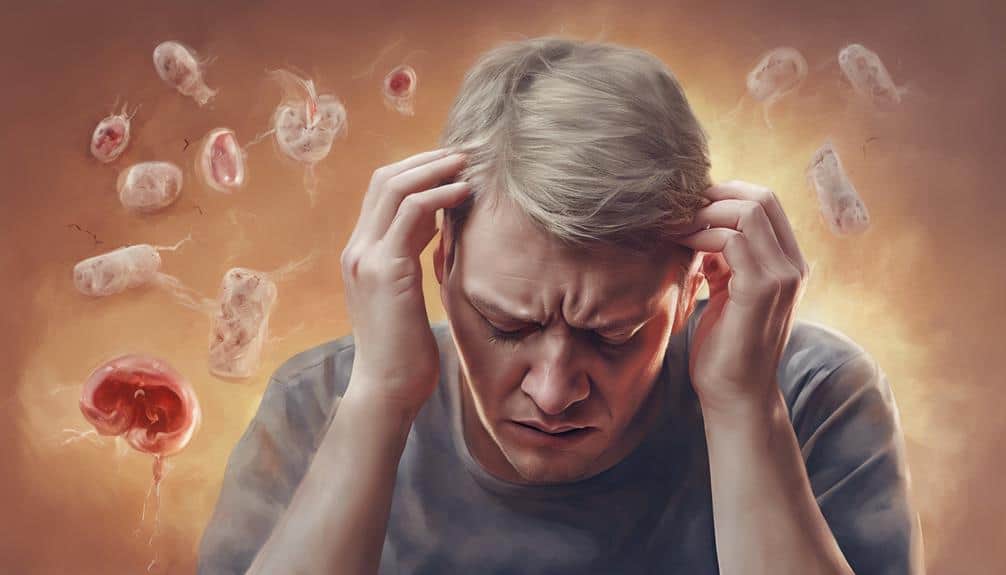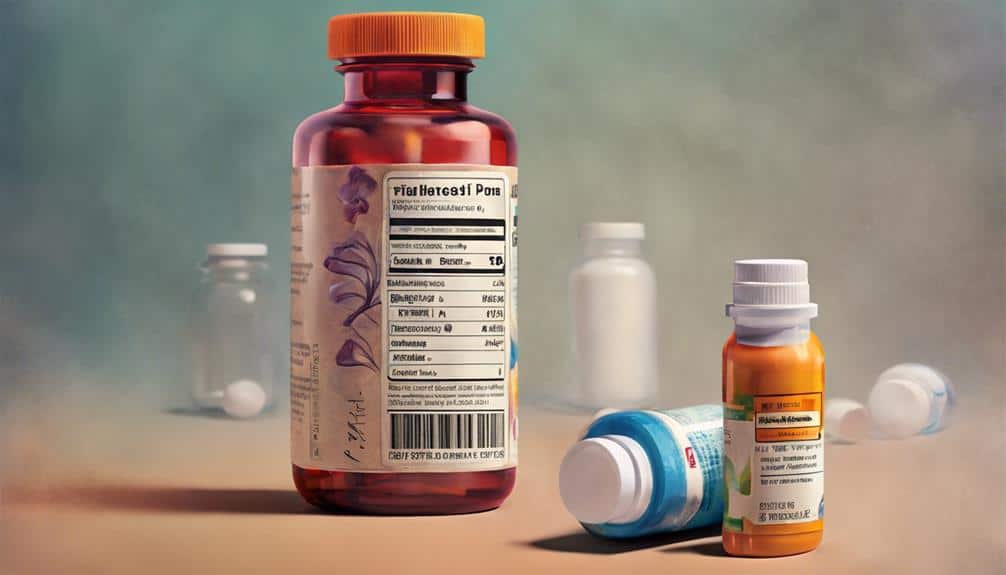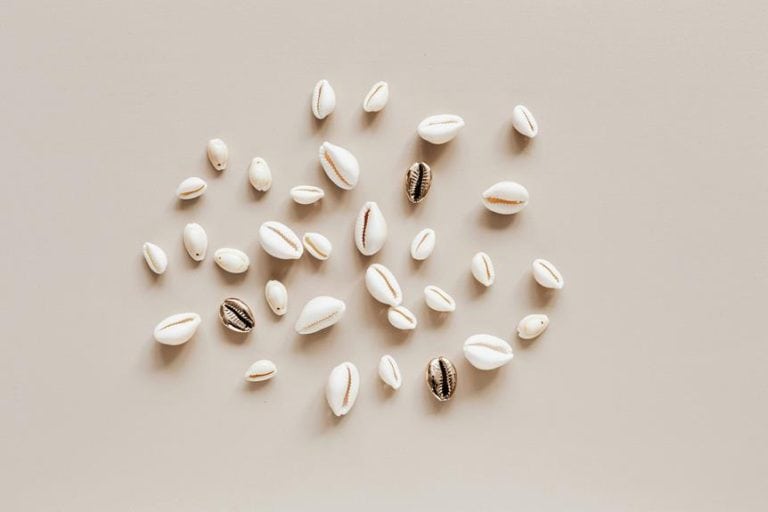Low Dose Naltrexone Adhd
Exploring the realm of ADHD treatment can feel like traversing a complex maze with countless twists and turns.
However, one intriguing path that has caught my attention is the potential use of Low Dose Naltrexone (LDN) for managing ADHD symptoms.
As I investigate the research surrounding LDN and its impact on dopamine and endorphins, a question lingers: could this lesser-known medication offer a promising alternative or complement to traditional ADHD treatments?
Key Takeaways
- LDN reduces stimulant-induced euphoria in ADHD
- Mitigates abuse potential when combined with stimulants
- Offers unique alternative for managing ADHD symptoms
- Dosage optimization crucial for effective treatment
Benefits of Using LDN for ADHD

Using low dose naltrexone (LDN) as an adjunct treatment for ADHD offers potential benefits in mitigating stimulant-induced euphoria and reducing abuse potential when combined with stimulants. Naltrexone, an opioid receptor antagonist, has demonstrated the ability to lessen the euphoric effects that stimulant medications can produce in individuals with ADHD.
By incorporating naltrexone into treatment plans alongside stimulants, there's a possibility of decreasing the likelihood of misuse or addiction to these medications. Clinical trials have shown promising results, such as reduced liking of stimulants when combined with naltrexone during the initial titration phase.
While further research is necessary to solidify these findings and understand the full extent of naltrexone's impact on stimulant-induced euphoria in ADHD, the exploration of non-addictive stimulant treatments in combination with opioid receptor antagonists presents a hopeful avenue for enhancing ADHD management strategies. This approach holds potential in addressing the complex interplay between ADHD symptoms, stimulant medications, and the risk of substance abuse.
Side Effects of LDN Treatment

As we explore the topic of side effects associated with LDN treatment for ADHD, it's significant to emphasize that common adverse reactions may include headaches, nausea, and insomnia.
While these effects are typically mild and transient, patients may also encounter vivid dreams or changes in mood during LDN therapy.
It's essential to discuss any concerns about side effects with a healthcare provider to effectively manage and address them.
Common Side Effects
Experiencing common side effects is a possibility for individuals undergoing low dose naltrexone (LDN) treatment for ADHD, with symptoms such as headaches, nausea, and dizziness being frequently reported. These side effects, while generally mild, can still impact daily life.
Here are some common side effects of LDN therapy for ADHD:
- Headaches
- Nausea
- Dizziness
Monitoring these symptoms and consulting with healthcare providers if they persist or worsen is crucial. Understanding these potential side effects can help individuals make informed decisions about their treatment plan. While side effects are common with LDN therapy, they're often temporary and may subside as the body adjusts to the medication.
Managing Side Effects
Individuals undergoing low dose naltrexone (LDN) treatment for ADHD can effectively manage common side effects by proactively addressing and adjusting to potential symptoms. Common side effects such as vivid dreams, insomnia, and headaches are typically critical and diminish as the body adapts to LDN. Adjusting the timing of medication intake or starting with a lower dose can help alleviate mild side effects.
It's important to promptly communicate any persistent or severe side effects to a healthcare provider for proper management. Monitoring side effects closely during the initial weeks of LDN treatment is essential to optimize the therapeutic benefits while minimizing discomfort. By staying proactive and seeking guidance from healthcare professionals, individuals can navigate and manage side effects effectively throughout their LDN therapy for ADHD.
Rare Adverse Reactions
Rare adverse reactions to low-dose naltrexone (LDN) treatment may manifest as vivid dreams or nightmares. While these occurrences are infrequent, they can be unsettling for individuals undergoing LDN therapy. Additionally, temporary changes in liver function tests have been reported in some cases, emphasizing the importance of monitoring liver health during treatment.
To further understand the potential rare adverse effects of LDN, it's essential to take into account the following:
- Vivid dreams or nightmares may disrupt sleep patterns and impact overall well-being.
- Abnormal results in liver function tests could necessitate adjustments in LDN dosage or additional medical attention.
- Gastrointestinal issues like diarrhea or constipation may also arise as rare side effects of LDN therapy.
Effectiveness of LDN for ADHD

During the titration phase of a study on LDN for ADHD, significant reductions in the euphoric effects of stimulants were observed with the use of naltrexone. This reduction in euphoria during the heightened risk titration phase in individuals with ADHD suggests a potential role for naltrexone in mitigating stimulant abuse potential.
However, it's important to note that naltrexone didn't impact euphoria during the maintenance phase of the study. These findings indicate that opioid receptor antagonists like naltrexone may hold promise in helping to reduce the abuse potential associated with stimulant medications in individuals with ADHD.
Further research is necessary to validate the effects of naltrexone on stimulant-induced euphoria and to explore the possibility of using naltrexone in combination with stimulants for the treatment of ADHD. This study provides valuable insights into the potential effectiveness of naltrexone in addressing stimulant abuse potential in individuals with ADHD.
LDN Vs. Traditional ADHD Medications

Comparing LDN with traditional ADHD medications reveals a distinct approach in treating ADHD, highlighting the potential for LDN to offer a unique alternative for managing ADHD symptoms.
When considering LDN as an alternative treatment for ADHD, several key points emerge:
- Addressing ADHD symptoms differently: LDN's immune system modulation and impact on endorphin release offer a novel way to manage ADHD symptoms compared to traditional stimulant medications.
- Reducing euphoria: LDN may work by reducing the stimulant-induced euphoria associated with traditional ADHD medications, providing a different mechanism to manage symptoms.
- Offering an alternative: LDN's effectiveness in managing ADHD symptoms may vary from traditional stimulant medications, making it a potential alternative for individuals seeking different treatment options.
Dosage and Administration of LDN

The recommended starting dose of Low Dose Naltrexone (LDN) for ADHD in adults typically ranges from 1.5 to 4.5 mg per day. This dosage can be adjusted gradually based on individual response, with the maximum dose generally falling between 4.5 to 9 mg per day.
It's advisable to take LDN at night to align with the body's natural endorphin production rhythm. Importance in timing and adherence to the prescribed administration schedule are essential for maximizing the therapeutic effects of LDN in managing ADHD symptoms effectively.
Consulting a healthcare provider or LDN specialist is essential to establish the most suitable dosage and administration plan tailored to individual needs. By following the recommended dosage guidelines and administration instructions, individuals can optimize the potential benefits of LDN therapy for ADHD while minimizing the risk of adverse effects.
Considerations Before Trying LDN

Before considering trying Low Dose Naltrexone (LDN) for ADHD, consulting a healthcare provider is important to evaluate its suitability for your individual needs and circumstances. When contemplating LDN therapy, there are several key considerations to keep in mind:
- Dose Adjustment: LDN requires precise dosing tailored to each individual. Working closely with your healthcare provider to determine the appropriate dosage is essential for the therapy to be effective.
- Understanding Side Effects: It is crucial to be aware of how LDN may work for us and the possible side effects it can cause. Being informed about both the benefits and risks of LDN treatment is crucial for making an educated decision.
- Compatibility Check: Considering existing medical conditions and medications is necessary to ensure that LDN is compatible with your health status. Discussing any potential interactions with your healthcare provider is vital to avoid adverse effects.
Taking these factors into account before embarking on LDN therapy can help optimize the treatment's effectiveness and safety for individuals with ADHD.
Frequently Asked Questions
Can LDN Be Used as a Standalone Treatment for ADHD, or Should It Be Used in Conjunction With Traditional ADHD Medications?
I believe that LDN's effectiveness and side effects should be considered. Understanding LDN dosage, frequency, long-term benefits, and risks is essential. It's important to weigh all these factors when deciding if LDN can be used alone or with traditional ADHD medications.
Are There Any Specific Dietary Restrictions or Lifestyle Changes That Should Be Followed While Taking LDN for Adhd?
Like a well-tuned machine, maintaining balance is key. Diet modifications, exercise routines, and proper sleep patterns can enhance the effects of treatment. Consistency in these areas can optimize health outcomes while on medication.
How Long Does It Typically Take to See Improvements in ADHD Symptoms After Starting LDN Treatment?
Typically, it takes a few weeks to notice improvements in ADHD symptoms after starting treatment. Monitoring progress, adjusting dosage, managing side effects, seeking support, tracking improvements, and setting goals are essential steps to guarantee effectiveness.
Are There Any Known Drug Interactions With LDN That Individuals With ADHD Should Be Aware Of?
When considering drug interactions, it's crucial to be cautious. Understanding potential side effects, efficacy studies, and long-term effects is key. Awareness empowers me to make informed decisions about my health and well-being.
Is LDN Safe to Use in Children and Adolescents With ADHD, or Is It Primarily Recommended for Adults?
In considering safety concerns, age appropriateness, and long-term effects, it is crucial to evaluate if LDN is suitable for children and adolescents with ADHD or primarily recommended for adults. This assessment must prioritize well-being and efficacy.
Conclusion
To sum up, Low Dose Naltrexone (LDN) shows promise in managing ADHD symptoms by impacting dopamine production and endorphin release. Despite potential benefits, further research is needed to confirm its effectiveness and safety.
Could LDN be the next breakthrough in ADHD treatment? Only time and continued studies will provide the answer. Consider discussing LDN with your healthcare provider to explore this potential option for managing ADHD.







